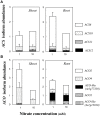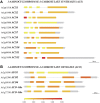A Comparative Study of Ethylene Emanation upon Nitrogen Deficiency in Natural Accessions of Arabidopsis thaliana
- PMID: 26904047
- PMCID: PMC4748056
- DOI: 10.3389/fpls.2016.00070
A Comparative Study of Ethylene Emanation upon Nitrogen Deficiency in Natural Accessions of Arabidopsis thaliana
Abstract
An original approach to develop sustainable agriculture with less nitrogen fertilizer inputs is to tackle the cross-talk between nitrogen nutrition and plant growth regulators. In particular the gaseous hormone, ethylene, is a prime target for that purpose. The variation of ethylene production in natural accessions of the model species Arabidopsis thaliana was explored in response to the nitrate supply. Ethylene was measured with a laser-based photoacoustic detector. First, experimental conditions were established with Columbia-0 (Col-0) accession, which was grown in vitro on horizontal plates across a range of five nitrate concentrations (0.5, 1, 2.5, 5, or 10 mM). The concentrations of 1 and 10 mM nitrate were retained for further characterization. Along with a decrease of total dry biomass and higher biomass allocation to the roots, the ethylene production was 50% more important at 1 mM than at 10 mM nitrate. The total transcript levels of 1-AMINOCYCLOPROPANE-1-CARBOXYLIC ACID SYNTHASES (ACS) in roots and those of ACC OXIDASES (ACO) in shoots increased by 100% between the same treatments. This was mainly due to higher transcript levels of ACS6 and of ACO2 and ACO4 respectively. The assumption was that during nitrogen deficiency, the greater biomass allocation in favor of the roots was controlled by ethylene being released in the shoots after conversion of ACC originating from the roots. Second, biomass and ethylene productions were measured in 20 additional accessions. Across all accessions, the total dry biomass and ethylene production were correlated negatively at 1 mM but positively at 10 mM nitrate. Furthermore, polymorphism was surveyed in ACC and ethylene biosynthesis genes and gene products among accessions. Very few substitutions modifying the amino acids properties in conserved motifs of the enzymes were found in the accessions. Natural variation of ethylene production could be further explored to improve Nitrogen Use Efficiency (NUE), in particular by manipulating features like the biomass production and the timing of senescence upon nitrogen limitation.
Keywords: Arabidopsis; biomass; ethylene; natural variation; nitrogen.
Figures






Similar articles
-
The Ethylene Biosynthetic Enzymes, 1-Aminocyclopropane-1-Carboxylate (ACC) Synthase (ACS) and ACC Oxidase (ACO): The Less Explored Players in Abiotic Stress Tolerance.Biomolecules. 2024 Jan 11;14(1):90. doi: 10.3390/biom14010090. Biomolecules. 2024. PMID: 38254690 Free PMC article. Review.
-
Cadmium-induced ethylene production and responses in Arabidopsis thaliana rely on ACS2 and ACS6 gene expression.BMC Plant Biol. 2014 Aug 1;14:214. doi: 10.1186/s12870-014-0214-6. BMC Plant Biol. 2014. PMID: 25082369 Free PMC article.
-
Molecular basis of differential nitrogen use efficiencies and nitrogen source preferences in contrasting Arabidopsis accessions.Sci Rep. 2018 Feb 20;8(1):3373. doi: 10.1038/s41598-018-21684-4. Sci Rep. 2018. PMID: 29463824 Free PMC article.
-
Natural variation of the root morphological response to nitrate supply in Arabidopsis thaliana.Mech Dev. 2013 Jan;130(1):45-53. doi: 10.1016/j.mod.2012.05.010. Epub 2012 Jun 7. Mech Dev. 2013. PMID: 22683348
-
1-Aminocyclopropane-1-Carboxylic Acid Oxidase (ACO): The Enzyme That Makes the Plant Hormone Ethylene.Front Plant Sci. 2019 May 29;10:695. doi: 10.3389/fpls.2019.00695. eCollection 2019. Front Plant Sci. 2019. PMID: 31191592 Free PMC article. Review.
Cited by
-
Exogenous glycine inhibits root elongation and reduces nitrate-N uptake in pak choi (Brassica campestris ssp. Chinensis L.).PLoS One. 2018 Sep 21;13(9):e0204488. doi: 10.1371/journal.pone.0204488. eCollection 2018. PLoS One. 2018. PMID: 30240454 Free PMC article.
-
The Ethylene Biosynthetic Enzymes, 1-Aminocyclopropane-1-Carboxylate (ACC) Synthase (ACS) and ACC Oxidase (ACO): The Less Explored Players in Abiotic Stress Tolerance.Biomolecules. 2024 Jan 11;14(1):90. doi: 10.3390/biom14010090. Biomolecules. 2024. PMID: 38254690 Free PMC article. Review.
-
Variations in Nitrogen Metabolism are Closely Linked with Nitrogen Uptake and Utilization Efficiency in Cotton Genotypes under Various Nitrogen Supplies.Plants (Basel). 2020 Feb 15;9(2):250. doi: 10.3390/plants9020250. Plants (Basel). 2020. PMID: 32075340 Free PMC article.
-
Ethylene Signaling under Stressful Environments: Analyzing Collaborative Knowledge.Plants (Basel). 2022 Aug 25;11(17):2211. doi: 10.3390/plants11172211. Plants (Basel). 2022. PMID: 36079592 Free PMC article. Review.
References
-
- Borch K., Bouma T. J., Lynch J. P., Brown K. M. (1999). Ethylene: a regulator of root architectural responses to soil phosphorus availability. Plant Cell Env. 22, 425–431. 10.1046/j.1365-3040.1999.00405.x - DOI
LinkOut - more resources
Full Text Sources
Other Literature Sources
Molecular Biology Databases

